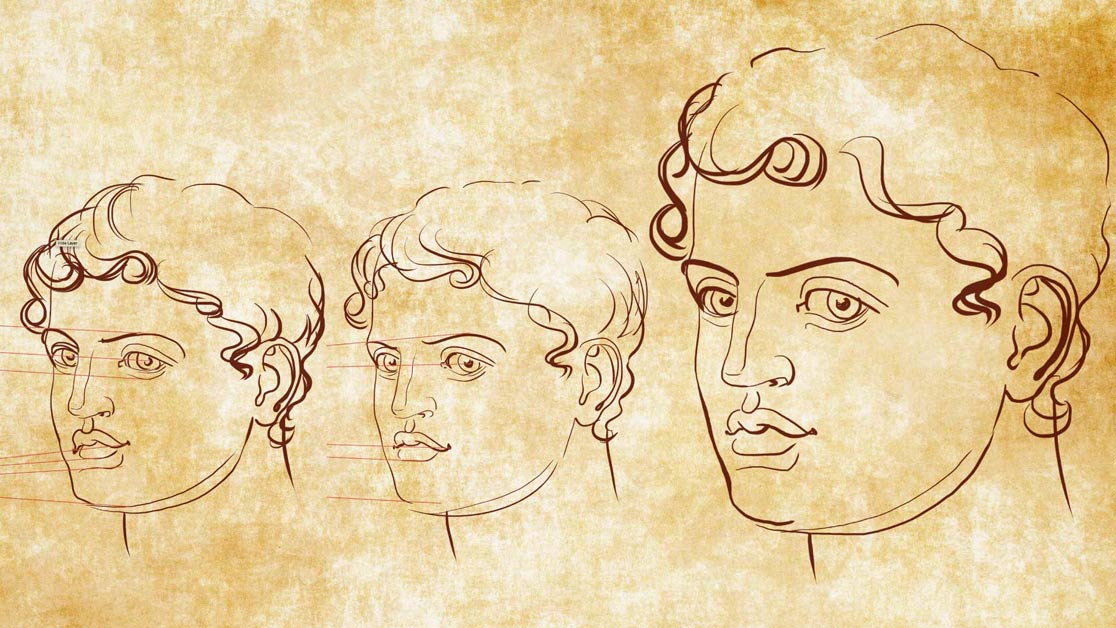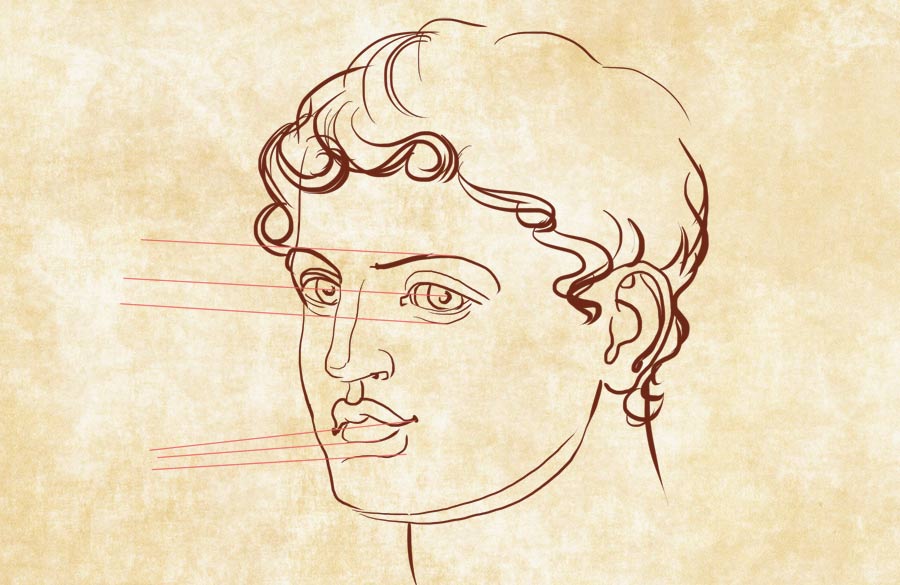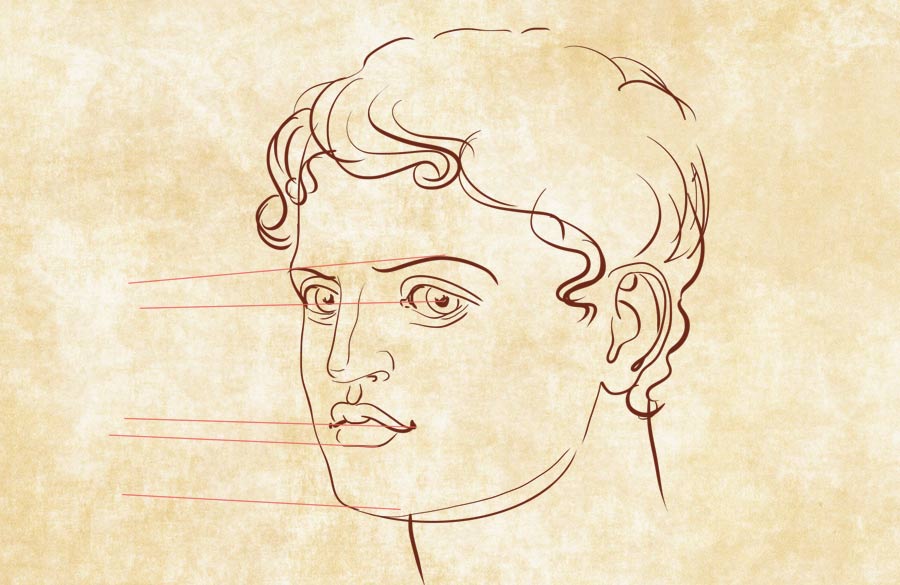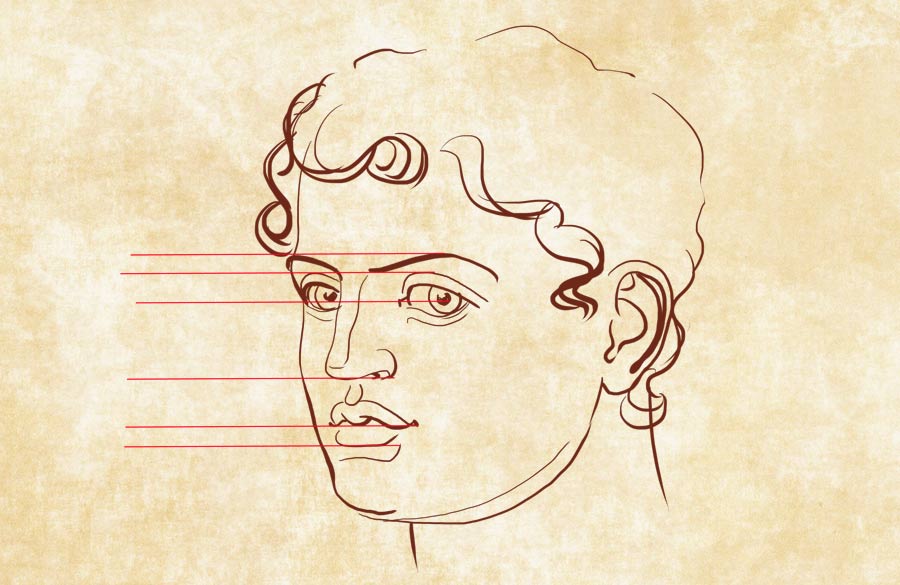How to Draw Portraits in Perspective
Enroll in the Life Drawing Academy now!
How to Draw Portraits in Perspective
By Vladimir London, Life Drawing Academy tutor

As an art tutor, I often receive portrait artworks for critique. Many drawings have the same common mistakes. One of such mistakes is using an incorrect perspective. To show you what this mistake is about, I will make this fast sketch, intentionally distorting placements of facial features. I would like not to overdo such distortion, though. It will be a recognizable portrait with believable proportions.
Seeing mistakes is a skill on its own. If you are a beginner, you may think that there is nothing wrong with this drawing, but depending on your experience, you may notice that although proportions and construction is more or less in place, the perspective is really off.
You can see that the level of eyebrows and the lines of eyes are pointing slightly upward as if the horizon level is above. At the same time, the lines in the mouth area are pointing downward. Because vanishing lines are not converging, but diverging, it results in reverse perspective. This is the mistake I want you to avoid in your portrait artworks.

Portrait in two-point perspective
Now, let's draw a portrait in two-point perspective. I will make a new sketch of the same face. This time, I will correct the previous mistake and place the facial features in two-point perspective. I draw from imagination. This is a not a hyper-realistic portrait, but rather stylized image.
To draw a good portrait, an artist has to know several things – constructive drawing, anatomy for artists and classical proportions of a human head. All these topics you can learn in the Life Drawing Academy Correspondence Course. In this course, you will get unlimited, one-to-one personal tutoring from professional artists and art teachers. This course is unique because your drawing curriculum will be custom-tailored to your skills and needs. You will learn strong draw skills by making up to 100 practical tasks. Every task will be fully explained and your artworks will be assessed. The academy tutors will teach you as long as it takes to raise your drawing skills to the advanced level.
I'm drawing on the tablet, but digital medium is just a way of making art. The skills you will learn in the Life Drawing Academy course are needed for every drawing medium you may use.
For example, the knowledge of human head anatomy and proportions is required no matter what medium you use – digital drawing, oil painting or sketching in traditional pen-and-ink.
This course covers so many topics, including linear and aerial perspective, principles of constructive drawing, classical canons of proportions, golden ratio, human anatomy for artists, rules of composition, proficient rendering techniques, how to make figurative artworks, and so on. If you are really serious about getting good drawing skills, you won't get the same quality art education anywhere else. This course is unique and offers great value for money.
The second sketch has the same face; this time, its facial features are placed in two-point perspective. Let's check this perspective with vanishing lines. You can see that lines of the eyebrows, eyes, and mouth are converging. They will meet somewhere on the horizon in one vanishing point. Another vanish point is also beyond the drawing area on the right-hand side. This makes it two-point perspective.

Portrait in parallel perspective
I will make another drawing in the parallel perspective. Technically speaking, because a human head is a three-dimensional object, which has its height, width and depth, it is correct to assume that it should be depicted in the two-point perspective as I just demonstrated in the previous sketch. However, if you examine the art by the Old Masters you would find that the great artists seldom used two-point perspective to portray people. Instead, they used the parallel perspective.
You may ask, what it is and why it is better to use this king of perspective. Parallel perspective is when vanishing lines are not converging or diverging, but parallel to each other.
A head is a relatively small object and we usually see other people from some distance. Also, our brain reinterprets the picture and minimizes distortions. Such distortions are very noticeable when you take a photo of a person or a selfie from close distance. Because we so used to photo images and pictures on TV and computer screens, photo-perspective became a part of our life and no longer looks unnatural. Before photography, artists had different view of the world and made their art as perceived by their mind, not by lenses of a photo camera.
Once again, I'm drawing the same face, using the same classical proportions. But this time, the perspective is different. Talking of proportions, I will briefly mention that a proficient artist has to know more than 20 different proportions and many rules of alignments to make a realistic portrait. If you are not sure what those proportions and alignments are, you can learn good drawing skills in the Life Drawing Academy course.
Now, let's check how the parallel perspective works. As you can see, in this sketch, the lines of eyebrows, eyelids, base of the nose, and chin are parallel to each other. They also happen to be horizontal, but this is because we see this portrait at our level, not above or below.

I'm not sure about you, but to me perspective in this sketch looks more natural than in the previous two.
I hope you have learned something new.
For digital drawing, I was using Xencelabs Tablet and pressure sensitive pen.
- Official Website: https://www.xencelabs.com/
- Amazon US: https://www.amazon.com/xencelabs
- Amazon UK: https://www.amazon.co.uk/xencelabs
- Amazon Germany: https://www.amazon.de/xencelabs
- Amazon France: https://www.amazon.fr/xencelabs
- Amazon Italy: https://www.amazon.it/xencelabs
- Amazon Spain: https://www.amazon.es/xencelabs
To learn good drawing techniques, enroll in the Life Drawing Academy course:
Online Course
A self-study, self-paced course for you to learn fundamental methods of classical drawing and improve life drawing skills by watching video lessons and doing assignments
- Unlimited access to 52 life drawing video lessons
- Lifetime membership without deadlines
- Unlimited support from the Academy tutors
- Constructive critique of your artworks
- Member access to the Academy's Art community
- Place in the Academy's Students Gallery
- Exclusive members-only newsletter and bonuses
- Life Drawing Academy Diploma of Excellence in your name
One-time payment - Lifetime membership
$297 USD
Personal Tutoring Online + Online Course
The ultimate choice if you who would like to receive personal, one-to-one tutoring from the Academy teachers, which is custom-tailored to your skills and needs
- Everything in Online Course, plus:
- Dedicated team of art tutors
- Assessment of your current level of drawing skills
- Personalized curriculum tailored to your skills and goals
- Up to 100 drawing tasks with by-task assessment
- Unlimited one-to-one personal coaching with detailed per-task instructions and feedback
- Artwork critiques and results-oriented guidance
One-time payment - Lifetime membership
$997 USD




